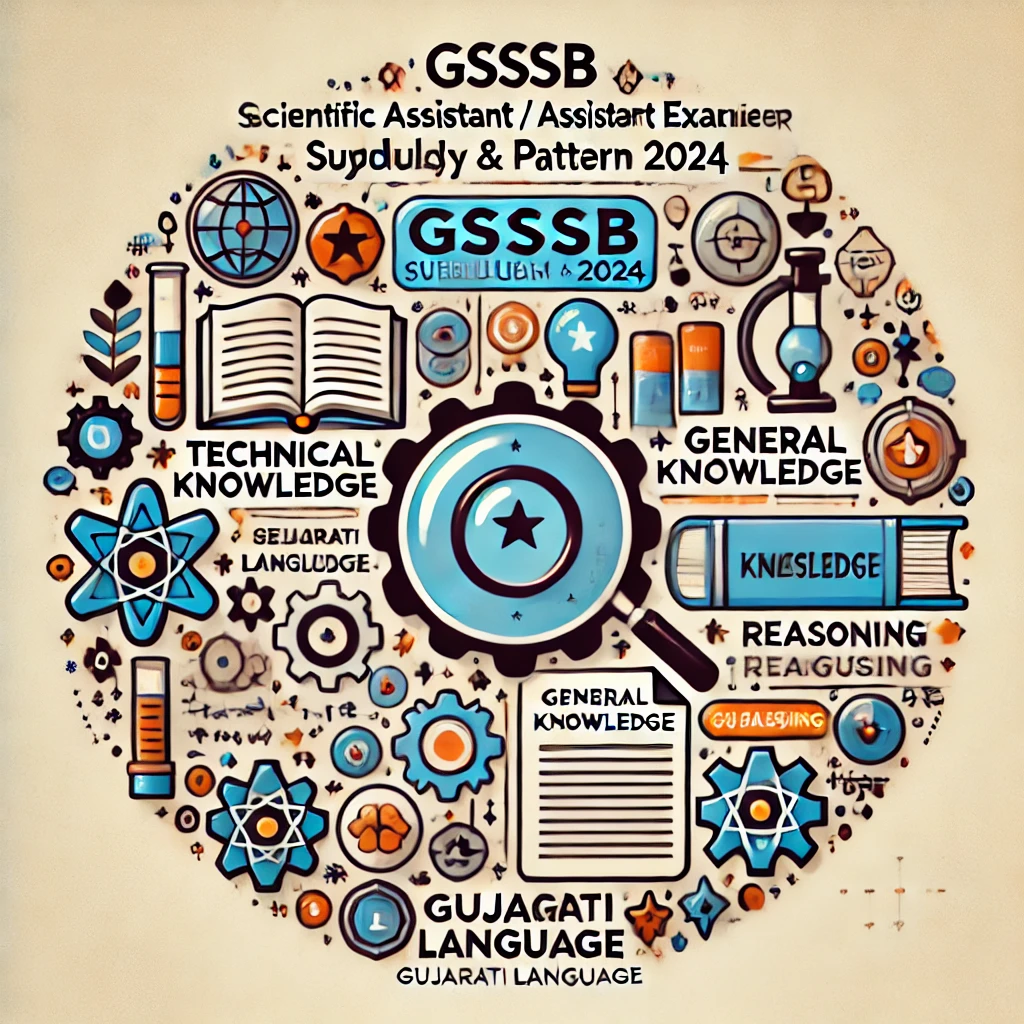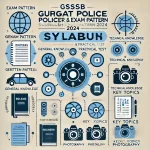Gujarat Subordinate Service Selection Board (GSSSB) will going to conducts exams for the recruitment of Scientific Assistant and Assistant Examiner in Director’s Office of Judicial and Forensic Sciences, Gandhinagar. The GSSSB Scientific Asst and Asst Examiner Exam 2024 aims to assess candidate’s technical knowledge related to his/her field, logical aptitude and reasoning with other educational skills.
A detailed and clear understanding of the Gujarat Scientific Assistant / Examiner syllabus and exam pattern is essential for candidates to perform well in the exam. This post provides a detailed guide to GSSSB Forensic Scientific Assistant and Assistant Examiner Syllabus 2024, along with exam pattern to prepare for its written exam.

Contents
- 1 GSSSB Scientific Assistant & Examiner Exam Pattern 2024
- 2 Subject-Wise Marks Distribution:-
- 3 Scientific Assistant Physics Syllabus
- 4 Scientific Assistant Biology Syllabus
- 5 Assistant Examiner of Questioned Document Syllabus
- 6 Important Links
- 7 Gujarat Assistant Examiner/ Scientific Assistant Syllabus 2024
- 8 Frequently Asked Questions:-
GSSSB Scientific Assistant & Examiner Exam Pattern 2024
The GSSSB scientific assistant and assistant examiner is under direct recruitment hence follows a written test followed by a document verification process. The written exam is objective in nature and consists of multiple-choice questions (MCQs).
Key Points about the Lab Asst & Technician Exam Pattern:
- Mode of Exam: Offline (OMR-based)
- Type of Questions: Objective (Multiple Choice Questions)
- Total Marks: 210 marks
- Duration: 180 minutes
- Subjects Covered: Logical Ability and Data Interpretation, Technical Knowledge, General Awareness, Constitution, Numerical Ability and Gujarati & English Language.
- Minimum Qualifying Marks in Part A: 40%
- Minimum Qualifying Marks in Part B: 40%
Subject-Wise Marks Distribution:-
| Part A | Questions | Max Marks |
| Logical Ability and Data Interpretation | 30 | 30 |
| Mathematical Ability | 30 | 30 |
| TOTAL | 60 | 60 |
| Part B | ||
| Questions related to Constitution of India,
Current Affairs, Gujarati and English Comprehension |
30 | 30 |
| Subject Related Topics | 120 | 120 |
| TOTAL | 150 | 150 |
| GRAND TOTAL | 210 | 210 |
| DURATION: 3 Hours (180 Minutes) |
GSSSB Scientific Assistant / Assistant Examiner Syllabus 2024
Reasoning and Data Interpretation (30 Questions, 30 Marks):- This section evaluates logical thinking, pattern recognition, and problem-solving abilities.
- Problems on Ages
- Venn Diagram
- Visual reasoning
- Blood relation
- Arithmetic reasoning
- Data interpretation (charts, graphs, tables)
- Data sufficiency
Mathematical/ Numerical Ability (30 Questions, 30 Marks):- To assess candidate’s knowledge of numerical ability. The topics includes:-
- Number Systems
- Simplification and Algebra
- Arithmetic and Geometric Progression
- Average
- Percentage
- Profit-Loss
- Ratio and Proportion
- Partnership
- Time and Work
- Time, Speed and Distance
- Work, Wages and chain rule
Constitution of India (10 Questions, 10 Marks):-
- Preamble of the Constitution
- Fundamental rights
- Directive principles of state policy
- Fundamental Duty
- Power, role and responsibility of President, vice president and governor
- Parliamentary system
- Amendment of Indian constitution, emergency provisions in Indian constitution
- Centre – State Government and their relation
- Judicial System of Indian Constitution
- Constitutional body
Current Affairs (10 Questions, 10 Marks):- Current events of state, national and international importance
Comprehension (Gujarati {5 marks} & English {5 marks}) (10 Questions, 10 Marks):- To assess comprehension, interpretation and inference skills in both Gujarati and English. A paragraph given with set of question on the basis of paragraph Or statement and assertion type question can be asked.
Questions and its Applications related to Technical Qualification of Scientific Assistant and Assistant Examiner (120 Questions, 120 Marks):-
Scientific Assistant Physics Syllabus
- Motion in a plane, cases of uniform velocity and uniform acceleration, Projectile motion, Equations of motion of projectiles, effect of air resistance on trajectory, uniform circular motion, law of conservation of linear momentum and its applications, Dynamics of uniform circular motion, centripetal force and its examples.
- E.M.Waves: Displacement current, E.M. waves and their characteristics, Transverse nature of E.M. wave, Electromagnetic spectrum, Maxwell’s equations in free space and linear isotropic media, boundary conditions on the fields at interfaces, scalar and vector potentials, E.M. waves in free space, Poynting vector.
- Optics: Reflection of light, spherical mirrors, mirror formula, refraction of light, Total internal reflection and its applications, Optical fibers, Refraction at spherical surfaces, lenses, Magnification power of a lens, combination of thin lenses in contact.
- Optical instruments: Human eye, image formation and accommodation, Microscopes and astronomical telescopes and their magnifying powers. Resolving power of microscopes and telescopes, Polarization, plane polarized light and its uses, circularly polarized light, Elliptically polarized light, Polaroids.
- Wave: Wave motion, Longitudinal and transverse waves, speed of wave motion, displacement relation for a progressive wave, principle of superposition of waves, Reflection of waves, Beats, Doppler effect.
- Acoustics: Generation of ultrasonic waves and applications, Piezo electric effect and quartz crystal, energy density of acoustic waves, acoustic intensity, Reflection and transmission of acoustic waves, Acoustics of buildings, reverberation time, Sabine’s formula.
- Atomic & Molecular Physics: Stern-Gerlach experiments, electron spin, fine structure of hydrogen atom, L-S coupling, j-j coupling, Spectroscopic notations and atomic states, Zeeman effect, Rotational, vibrational and electronic spectra of molecules, Raman effect and molecular structure, Laser Raman spectroscopy, Fluorescence and Phosphorescence, Theory and application of NMR and EPR.
- UV and Visible spectrophotometry: types of sources, stability, wavelength selection, filter cells, sampling devices, Lambert and Beers Law, Calibration of instrument, Atomic absorption spectrophotometry.
- Lasers: Spontaneous and stimulated emission. Einstein’s Coefficients, optical pumping, population inversion; Solid state laser and Gas lasers.
- Nuclear Physics: Basic nuclear properties, semi empirical mass formula and applications, Mass parabolas: Ground state of a deuteron, magnetic moment and non central forces, Meson theory of nuclear forces, salient features of nuclear forces, Shell model of the nucleus- success and limitation, violation of parity in β-decay, r- decay and internal conversion, Mossbauer spectroscopy, Q-value of nuclear reactions, Nuclear fission and fusion, Nuclear reactors.
- Solid State Physics: Crystalline and amorphous structure of matter, Different crystal systems, Methods of determination of crystal structure, X-ray diffraction, Scanning and transmission electron microscope (SEM/TEM); Band theory of solids- conductors, insulators and semi conductors; Thermal properties of solids, specific heat, Debye theory; Magnetism: dia, para and ferro magnetism, superconductivity, Energy dispersive X-ray, Atomic force microscope, Dispersive X-ray analysis (EDX), Wavelength dispersive X-ray analysis (WDX).
- Electronic: Semiconductor devices: diodes, transistors, field effect devices, amplifiers and oscillator circuits, frequency dependence and applications; optoelectronic devices: solar cells, photo- detectors, LED’s, Operational amplifiers and their applications.
- Logic circuits: OR, AND, NAND, NOT, NOR, XOR gates; Digital techniques and applications: Registers, counters, comparators and similar circuits. Flip-flops: RS, JK, Master- Slave JK, T-type and D-type flip-flops. Half adders and full adders, Decoders, Multiplexers, Encoders, digital comparators, A/D and D/A converters.
- Compunction Micro cafe: Evidence collection from crime scene, Homicide, Hanging, Strangulation, write blockers, Imaging of storage media and capturing of volatile evidence in computer fraud and cyber crime, Audio and video, CCTV footage, Paint, Glass, Soil, Fibre, Wildlife crime, Metals identifications, packing and preservation of exhibits, packaging and transportation of digital and electronic evidence, Tool marks, Phenomena of absorption, emission, reflection. Thermal detectors, photographic detectors, photoelectric detectors, Basic concept of atomic spectra, energy levels, quantum numbers, designation of states, selection rules and atomic spectra.
- Molecular binding, molecular orbital, types of molecular energies, spectra of polyatomic molecules. FTIR, Biometrics and forensic science-face, Iris and retinal imaging, speech recognition, finger prints, Automated Finger Identification System (AFIS), Lip prints, ear prints, Gait pattern, blood stain patterns, Foot prints and footwear impressions and seal impressions.
- Restoration of erased marks, cast, engraved and punched marks, skid marks, principle and techniques of black and white and coloured Forensic photography, cameras and lenses, working of SLR and DSLR cameras, basics of digital imaging photography, digital photography, photo- morphing, types and videography camera and lenses, basics of video codec and file formats, recording of playback technique of analog video recording.
- Units of measurements and their conversion, measure of mean, median and mode, Measures of Dispersion, Range, Mean deviation and Standard deviation, Correlation and Regression Analysis, Coefficient of variation, moment, coefficient of Regression, Correlation measurements, Probability theory, Test of significance of attributes, sample test, t-test and comparison of data sets, paired test, chi-square test, F-test for equality of variance, Large sample test, Normal test, Pearson’s square test, Derivation, Evaluation of evidence, Transfer of evidence, weight of evidence. Correspondence probabilities, analysis and synthesis of complex waves, anatomy of vocal formats, analysis of vocal sounds, frequency and overtunes.
- Electronics of audio recording, transmission and playback devices, noise and distortion, voice storage, and preservation, Forensic linguistics: phonetics, morphology, syntax, Semantics, Stylistics, Pragmatics, Script, Orthography and Graphology, difference between language and speech, Psycholinguistics, Neuro linguistics, Sociolinguistics, Scientific approaches; Reliability and admissibility of evidence in the court, Linguistic profile, language register.
- Discourse analysis: Connivance, acceptance, listening feedback and rejection in the context of Mens-Rea, Narrative, Dialectogy, linguistic variety as a geographical marker, Idiolect and speaker characterisation, Phonology, Morphology and word formation processes as individual linguistic abilities.
- Various approaches in forensic speaker identification, Instrumental analysis of speech sample, interpretation of result, statistical interpretation of probability scale, Objective /Subjective methods, discriminating test, closed test, open test, likelihood ratio calculation, concept of test and error identification. Techniques and best practices of examination of audio recording authentication.
- Introduction to Video technology: Electronic photography, Scanning, synchronising the analog signal, digital signal processing, colour videio, Digital Television standard, HD Video scopes, compression, Image acquisition and recording formats, optical media, Time code, Audio for video, Displays.
- Scope recognising CCTV evidence and its nature, types of DVRs, DVR recording, best practices of CCTV evidence, evidence retrieval and storage at scene of crime and laboratory, challenges and precaution at the scene of crime, Legal issues and recommended equipments needed collection, recovery, enhancement, analysis and interpretation of video evidence.
- Facial image recognition, Vehicle registration plate enhancement, foreign object detection, Authentication of video evidence, video source identification techniques.
- Introduction to nano-particles, nano-tubes, utilisation of nano-technology in analysis of physical evidences, application of nano technology in forensic evidence analysis.
- Faults and failure of evidence of Arson and fire due to electrical and mechanical faults/failure, 3-phase electricity and earth faults.
- Forensic engineering: Cement, Building materials, steel bars and metal Physics.
Scientific Assistant Biology Syllabus
- Zoology: Animal Diversity: Invertebrates and vertebrates. Anatomy and morphology of body organs of vertebrates and human.
- Histology: Epithelium and glands; classification of epithelia, types of glands; their classification and functions; connective tissues; fibers of connective tissues; functions of connective tissues; structure and functions of cartilage and bones.
- Osteology: Skeletal terminology; gross morphology of bones; basic human skeletal system.
Animal physiology with special reference to humans: Digestive; respiratory; endocrine; nervous; excretory; Reproductive; cardio-vascular; neuromuscular systems; sense organs; immune system; homeostasis. - Mammalian Embryology: Human embryology; Ageing; death; Regeneration and senescence.
- BOTANY: Plant classification systems, External and Internal Morphology of plants. Palynology and oncology, Seeds, Fruits and their dispesal. Plant tissues various poisonous plants: Abrus precatorius, Aconitum napellus, Argemone mexicana, Calotropis procera, Cannabis sativus, Claviceps purpurea, Croton tiglium, Erythroxylon cocao, Atrpa belladonna, Jatropha curcus, Ricinus communis, Strychnos nux vomica, Thevetia nerifolia, Neruum odoratum, Manihot utilissima, Cinchona officinalis, Daturra stramonium, Nicotiana tobaccum, Psalliota (mushroom) etc.
- Male and female reproductive organs of plants, Economic importance of food, sugar, fibers, timber, medicines, beverages and oil yielding plants. Elementary knowledge of toxic algae, diatoms. Fungi, mosses, ferns, lichens, cycads, conifers, viruses, bacteria and PPLO. Fossils, Plant responses to biotic and abiotic stresses (salt, drought, water logging etc) mineral nutrients and soilless culture.
- CELL BIOLOGY AND MOLECULAR BIOLOGY: Membrane structure and functions: role of cell membrane and transport of materials into and out of cell; cell organelles; cytoskeleton; nucleus; chromosomes; protein synthesis and its control; karyotyping; cell cycle and cell division; sex chromosomes and sex chromatin; tumours and cancer; molecular structure of DNA and RNA; DNA replication; DNA damage and repair; structure and functions of different RNAs; cell death; Hormonal receptor, cell signalling, cell surface receptors and secondary messengers.
- MICROBIOLOGY: Ultrastructure of microbes (bacteria and viruses); culture of bacteria; microbial diseases; microbial genetics, methods of genetic transfers, transformation, transduction, conjugation, sex-duction; micro-organism encountered in biological warfare.
- BIOCHEMISTRY: Structure, functions and metabolism of different biomolecules; Enzymes, their classification, regulation and kinetics; Isozymes and co-enzymes; stabilising interactions (Van der waals, hydrogen bonding and other interactions); Biophysical chemistry (PH, buffers, Reaction kinetics, thermodynamics, bioenergetics, ATP and high energy compounds, oxidative phosphorylation); blood coagulation; molecular mechanism of hormonal action.
- GENETICS, BIOTECHNOLOGY AND BIOINFORMATICS: Human genetic variations; Human chromosomes; Mendelian and non-Mendelian inheritance; inheritable human diseases; gene mapping and genetic risk assessment; gene pool; Hardy Weinberg equilibrium; deviation from Hardy Weinberg equilibrium; inbreeding; genotypes; phenotypes; mutation; multiple alleles; genetic variants; gene structure; gene expression; genetic markers and their significance; linkage and crossing over; sex determination; sex linked and sex influenced characters; human pedigree analysis; polygenic inheritance; gene identification and prediction tools; major data-basis in bioinformatics. Gene cloning and genetic engineering; r-DNA technology; Genomics and proteomics; Epigenetics;
- METHODS AND INSTRUMENTATION IN BIOLOGY: Analysis of DNA, RNA and proteins by one and two dimensional gel electrophoresis; Iso- electric focusing gels; molecular cloning of DNA and RNA, DNA sequencing methods; Isolation, separation and analysis of carbohydrates, proteins and lipid molecules, ELISA, RIA, western blot methods; fluocytometry and immune fluorescence microscopy; cell molecule detection and in- situ localization by FISH and GISH techniques; molecular analysis using UV/visible fluorescence, mass spectroscopy and surface plasma resonance methods; electrophoresis; different microscopes including scanning and transmission microscopes.
- ORIGIN OF LIFE AND EVOLUTION: Origin of life; evidences of evolution; modern theory of evolution; evolution of man.
- ECOLOGY AND ENVIRONMENTAL: Structure and functions of ecosystem; concept of habitat and niche; population and community ecology; laws of limiting factors; pollution and eutrophication; green house effect, Global warming and climate change; ozone depletion; Biodiversity and its management; conservation of natural resources (Renewable and non-renewable resources); sustainable development.
- FORENSIC BIOLOGY/SEROLOGY/DNA/PROFILING: History and development of forensic science in India and abroad- scope of F.Se. need of forensic science, basic principles of forensic science, tools and techniques, criminal profiling. Organization set up of forensic science laboratory, FBI, CFSL, FSL, NICFS, NCRB (Maintenance of crime Recordes, Mobile forensic science, Branches of forensic Science, IEA sec. 45, Cr.P.C. 293.
- Importance nature, location, collection and evaluation of biological material (blood, saliva, semen hair examination, application of blood groups and isozyme types in Forensic science.
- History and development of finger prints science for personal identification, variations in finger prints, causes and genetic basics of taking inked prints, devices and material for searching prints, classification of finger prints, pattern types, Henry system of classification (primary to tertiary and key classification) Henry system searching of fingers prints, classification system, single prints, chance prints, latent prints, development of latent finger prints, systematic approach to latent print processing, preserving and lifting of finger prints, comparison of finger prints, basic of comparison, class and individual characteristics, various types of ridge characteristic, AFIS, Presentation of expert evidence on finger prints in court.
- Wildlife forensics: Introduction, importance, wild (Protection) Act-1972, Protected and endangered species of animals and plants, identification of wild life materials (skin, fur, bones, nail, horn, teeth, plants, plant parts and product by conventional and modern methods, DNA techniques in wildlife investigation.
- Forensic entomology: Introduction, General entomology and arthropod biology, insects of forensic importance, collection of entomological evidence during death invesugations, role of aquatic insects in forensic investigations, insect succession on carrion and its relationship to determine time since death, factors influencing insect succession on carrion its application to forensic entomology, entomolotoxicology, insects as toxicological indicators, impact of drugs and toxins on insect development, molecular methods for forensic entomology.
- Botanical evidences: introduction, types, location collection, evaluation and forensic significance; wood (type of wood, their identification and comparison) leaves (identification of various types of leaves and their anatomy, methods of comparison fibers classification and identification of fibers.
- Pollens- Importance, structure, function, methods of identification and comparison. Lectins: forensic significance.
- Forensic diatomology:- Diatoms Nature, location structure, extraction from various body tissues including bone marrow, preparation of slides, methods of identification and comparison, forensic significance.
- Forensic microbiology: types and identification of microbial organism of forensic significance
forensic medicine: seasonal offences and causes signs of death and changes of death, time since death, medico legal aspect of death. - DNA profiling: History of DNA typing, human genetics, heredity, alleles, mutations and population genetics, molecular biology of DNA, variation and polymorphism in DNA.
- DNA typing systems: RFLP analysis, PCR amplifications sequence polymorphism, analysis of SNP, Y-STR, Mitochondrial DNA, DNA Bar-coding for species identification, evaluation interpretations, allele frequency determination, match probability database, quality control, certification and accreditation.
- Forensic significance of DNA profiling: applications in disputed cases, child swapping, missing person’s identity, civil immigration, wildlife and mass disaster victim identification.
- Legal perspectives: legal standards for admissibility of DNA profiling, procedural and ethical concerns, status of development of DNA profiling in India and abroad and new future technologies DNA chips, SNPs and limitations of profiling.
- DNA binding proteins, factors affecting DNA, transcription and translation, pseudo genes, non coding genes, overlapping genes, status and development of DNA profiling CODIS. Isolation, quantification and quality assessment of DNA from hard and soft tissues, biological materials, Touch and trace DNA, collection preservation and packing of exhibits for DNA Avalos.
- PHYSICAL ANTHROPOLOGY: Forensic Anthropology: Definition, scope and problems. comparative skeletal anatomy of human and non-human. Classification of bones. Identification of bones and determination of site, age determination from skeletal remains. General considerations, suture closure in skull and ossification in other bones. Sex determination from skeletal remains: skull, pelvis and other bones. Estimation of stature from skeletal remains with special reference to long bones.
- Personal identification techniques as somatoscopy, somatometry, osteometry and craniometry, their importance. Portrait Parle/Bertillon system. for Forensic Composite imagery: photofit/identi kit system for facial reconstruction. Craniofacial superimposition techniques as photographic superimposition. Video-superimposition. Roentgenographic superimposition. Importance of tissue depth to reconstruct various facial features/genetic and congenital anomalies: causes, types, identification and their forensic significance.
- Forensic odontology and serology: Development and scope, role in mass disaster and anthropology, structural variation in teeth (human and non-human), types of teeth and their functions, determination of age from teeth, eruption sequence. Gustafson’s method, dental anomalies, their significance in personal identification.
- Application of serology in solving cases of disputed paternity, theft, rape, murder, etc. ABO, MN and Rh blood-groups and their inheritance. Blood groups determinations techniques, species origin and polymorphism from blood stains and other body fluids.
- Forensic Genetics: Human hereditary traits, dominant, codominant, recessive, sex- limited, sex-linked. Genetical hazards and counseling. Identification of twins: monozygotic and dizygotic.
Assistant Examiner of Questioned Document Syllabus
- Different Standard books and their writers in handwriting identifications, General materials used in paper manufacturing, chemicals used in safety and security papers, different kinds of inks and general methods of ink preparation and analysis, different types of magnifiers i.e hand magnifiers, illuminated magnifiers, binocular magnifiers and stereoscopic microscope, Various kinds of rays i.e. visible, I R, U V, and principles of infra- red photoscopy.
- Methods of Comparison of Questioned Writings and Signatures with the Standard writings and signatures. Procurement of Standard Writings and Signatures for Comparison, Kinds of Forgery, Symptoms of forgery, Erasure and kinds of erasures, method of detection of erasures, Disguise, Examination of Charred Document, definition of terms used in hand writing i.e. movement, skill, speed, natural variations, tremors, shading, alignments.
- Document photography, basic principles and techniques of black & white and colour photography, UV, IR, transmitted light photography, photomicrography and microphotography, type writing identification and its kinds, different types of defects in type writing and their identification.
- Identification of features of dot-matrix printers, Ink-jet printers, Laser-jet printers. Various printing processes i.e. letter press, lithography, and intaglio printing and their identifying features.
- Examination of photocopies and scanned documents, Various security features of Indian Bank Notes of higher denominations, E-passports, Credit/Debit/Smart cards, digitally manipulated documents, detection and decipherment of alteration, additions, overwriting, obliteration and erasures.
- Pure Physics: Motion in a plane, cases of uniform velocity, acceleration, projectile motion, Equation of motion of projectile, uniform circular motion, law of conservation of linear momentum and its application, dynamics of uniform circular motion centripetal force and its examples.Displacement current, EM waves and their characteristics, transverse nature of EM waves, electromagnetic spectrum, Reflection of light, spherical mirrors, mirror formula, refraction of light, total internal reflection and its applications, optical fibres, refraction at spherical surfaces, lenses, magnification power of lens, combination of the lenses in contact.
- Human eye, image formation and accommodation, microscopes, astronomical telescopes and their magnifying power, resolving power of microscope and telescopes, polarization, plane polarized light and its uses, circular polarized light, Elliptically polarized light, Polaroids UV and Visible spectrophotometery, stability wavelength detection, filter, cells, sampling devices, calibration of instrument, atomic absorption spectrophotometery, lasers.
- Crystalline and amorphous structure of matter, different crystal systems, methods of determination of crystal structure, X-ray diffraction, scanning and transmission electron microscope (SEM/TEM), superconductivity, energy dispersive-X-ray, dispersive X-ray analysis (EDX), wave length dispersive X-ray analysis (WDX), semiconductor devices- Diodes, transistors, field effect devices, amplifiers and oscillators, circuits, frequency dependence and applications, photo electronic devices, solar cells, photo detectors, LEDs.
- Chemistry: Atomic structure and periodic properties of elements, chemical bonding, IUPAC nomenclature of organic compounds and coordination complexes, principle of stereo chemistry, conformational analysis, isomerism, and chirality, reactive intermediates and organic reaction mechanism, concept of aromaticity, qualitative and quantitative analysis, mole concept, normality, molarity and molality, mole fraction and their calculations,
- Transition metals including inner transition metals, coordination chemistry, concept of acid and bases and its application in pH measurements, Chromatography, Gas Chromatography, HPTLC techniques, general principles of paper chromatography, column chromatography, TLC, X-ray, florescence analysis GC-MS, theory and principles of electrophoresis.
- Analysis of dyes and pigments, valence bond theory, molecular orbital theory, absorption spectra and magnetic properties of transition metal complexes.
- Principle and application of photochemistry, Javlonski diagram, quantum yield, photo-sensitization reactions, Norrish-I & Norrish- II
- Basic principles of green chemistry, green reagents, phase transfer and nano crystals, calculation of atom energy and E-factor.
Note: Syllabus for Scientific Assistant / Assistant Examiner has not yet announced officially by GSSSB. The syllabus given here is based on previous exam conducted for the same post by other commissions. Once released officially on their official website, it will be updated here.
Important Links
- Must See: GSSSB Scientific Assistant/Examiner Previous Year Question Paper PDF 2024
- Also See: GSSSB Lab Assistant/Technician Previous Year Question Papers PDF 2024
- Must See: GSSSB Lab Technician & Lab Assistant Syllabus 2024 with Exam Pattern
- Also See: GSSSB Gujarat Police Photographer Syllabus & Exam Pattern 2024
- For Latest GSSSB Updates:- https://4syllabus.in/tag/gsssb
- For Latest Government Jobs in Gujarat:- https://4syllabus.in/tag/gujarat/
- Official GSSSB Website:- https://gsssb.gujarat.gov.in
- For Official Assistant Examiner/ Scientific Assistant Notification:- CLICK HERE
Gujarat Assistant Examiner/ Scientific Assistant Syllabus 2024
The GSSSB Assistant Examiner/ Scientific Assistant Exam 2024 is an important opportunity for candidates aspiring to work in the forensic department. Understanding of syllabus and the exam pattern will help candidates prepare effectively for the written examination.
In case of any doubt, please use the comment section to drop your comment. Best of Luck!. Stay with us for more updates.
Frequently Asked Questions:-
How should I approach the Concerned Subject/ Technical Knowledge section?
Technical Knowledge section is crucial as it carries the maximum weightage. Focus on topics related to forensic science, lab analysis techniques, and scientific research. Referring to standard forensic science textbooks will be helpful.
Is the Gujarati & English language section mandatory for all candidates?
Yes. Compulsory for all posts.
Is there negative marking in the GSSSB Scientific Assistant / Assistant Examiner Exam 2024?
Yes, 1/4 marks for each wrong answer.
What are the key topics under the Technical Knowledge section for Scientific Assistant / Assistant Examiner?
- Forensic Science Basics: Study of biological, chemical, and physical evidence.
- Analytical Techniques: Chromatography, spectrometry, microscopy, etc.
- Toxicology: Poison analysis, drug identification.
- DNA Analysis & Serology: DNA profiling and blood-related examinations.
- Document Examination: Forgery detection, handwriting analysis.








what is official source of syllabus,plz provide link ,website etc
This is not an official syllabus declared by GSSSB. It has been taken from UKPSC Senior Scientist Assistant Exam 2023-24. It is meant for study reference only. Please wait for official syllabus. Thanks. Here is link:- https://psc.uk.gov.in/public/uploads/recruitment/1371683681.pdf Thank you.